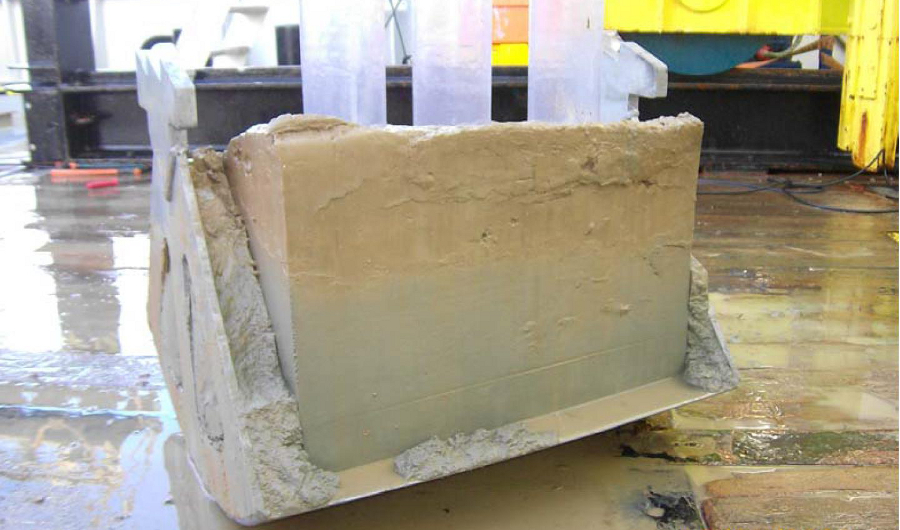Deep Ocean Currents Carry Plastic Microfibers Into Seafloor Hot Spots

Researchers gathered and tested sediment samples, like the one shown here, from the Mediterranean off the coast of Italy.
Image courtesy of Ian Kane.
(Inside Science) -- The deep waters of the Tyrrhenian Sea off the western Italian coast hold centuries' worth of shipwrecks and lost cargo from past civilizations. But new research shows that recent civilization has left a heavy burden on parts of the seafloor.
Researchers found an area of Mediterranean seabed that contains about 1.9 million pieces per square meter, one of the highest concentrations of microplastics per square meter ever reported.
"That's an incredibly high number, obviously," said Ian Kane, the lead author of a study published today in the journal Science.
Researchers who study the circulation of plastic have suggested that what we see on the surface of the water -- including the giant garbage patches drifting in various parts of the ocean – represent only about 1% of the plastic that's actually in the oceans. The other 99% is likely found on the seafloor, stored (temporarily) inside the creatures that ingest it, or even in snow.
Now Kane and his co-authors have found some of the plastic on the seafloor, stored in oceanic drifts. Kane, a sedimentologist at the University of Manchester, studies the way that mineral grains move around the earth. He thought that plastic particles likely moved in much the same way, and that plastic falling to the seabed might not necessarily sit directly underneath the massive floating garbage patches around the world.
"It's quite intuitive to us that the plastics are going to be distributed on the seafloor according to the currents which transport them," he said.
To test this theory, they looked at an area of the Mediterranean where they had detailed maps of the seafloor, ocean current models, and information of the strength of currents at different points. They then took samples of the seabed between the Italian island of Sardinia and the mainland.
They extracted the plastics from the seabed samples and found they were concentrated between depths of 600 meters and 900 meters, a place where the currents interact most strongly with the seafloor. In these areas, seafloor features known as ocean drifts, which are basically piles of materials miles in length and hundreds of feet high, similar to sand dunes or snow drifts, contained much larger proportions of microplastics than channels experiencing high currents, giving sediments less of a chance to settle.
Helge Niemann, a research leader at the Royal Netherlands Institute for Sea Research and a professor for microbial and isotope biogeochemistry at the University of Utrecht who was not involved in the recent study, calculated that you could fit about 100 million grains of sand measuring 0.1 millimeter in a square meter. In other words, Kane and his team would have seen roughly one piece of plastic for every 50 grains of sand.
"The study is interesting as it shows these bottom currents in the deep sea are important to the distribution of plastics," Niemann said. "One should not regard the ocean as a totally still basin."
Most of the plastic material Kane and his team found on the seafloor was made up of microfibers. These can come from fishing nets or ropes, but Kane said that most of it was likely washed down from rivers after passing through wastewater treatment plants unequipped to filter the material out, given that the Mediterranean is a relatively enclosed sea fed by plastic-rich rivers from large population centers.
"The numbers they get from this are difficult to translate to the entire ocean," Niemann said.
Many of the microfibers come from our own clothes. Kane said that much of this plastic could be filtered by using graphene or some other method in treatment if plants were to install such technology.
George Leonard, chief scientist with the Ocean Conservancy, an advocacy group based in Washington D.C., said the tiny size of most of these plastic fragments shows that efforts to clean up plastic from the ocean after the fact would be nearly impossible when it comes to microfibers.
Kane said that microplastics are found in just about everything we eat and drink. Clean microplastics may not present much of a problem. But these particles can collect heavy metals or other toxins such as DDT in the environment, which can have negative impacts on sea life.
"There's zero chance that we can go out and clean that pollution up," Leonard said, adding that most attention is focused on plastic bags or bottles floating around the ocean rather than these microfibers. "This really solidifies that the solution to ocean plastic pollution isn't in the ocean -- it's on land."
The other challenge is that the same currents that bring these plastic particles to the drifts also provide them with oxygen, possibly making them biodiversity hot spots, the authors said.
"It's not good if the system is disturbed too much, because it takes a long time for things to grow there," Niemann said.

